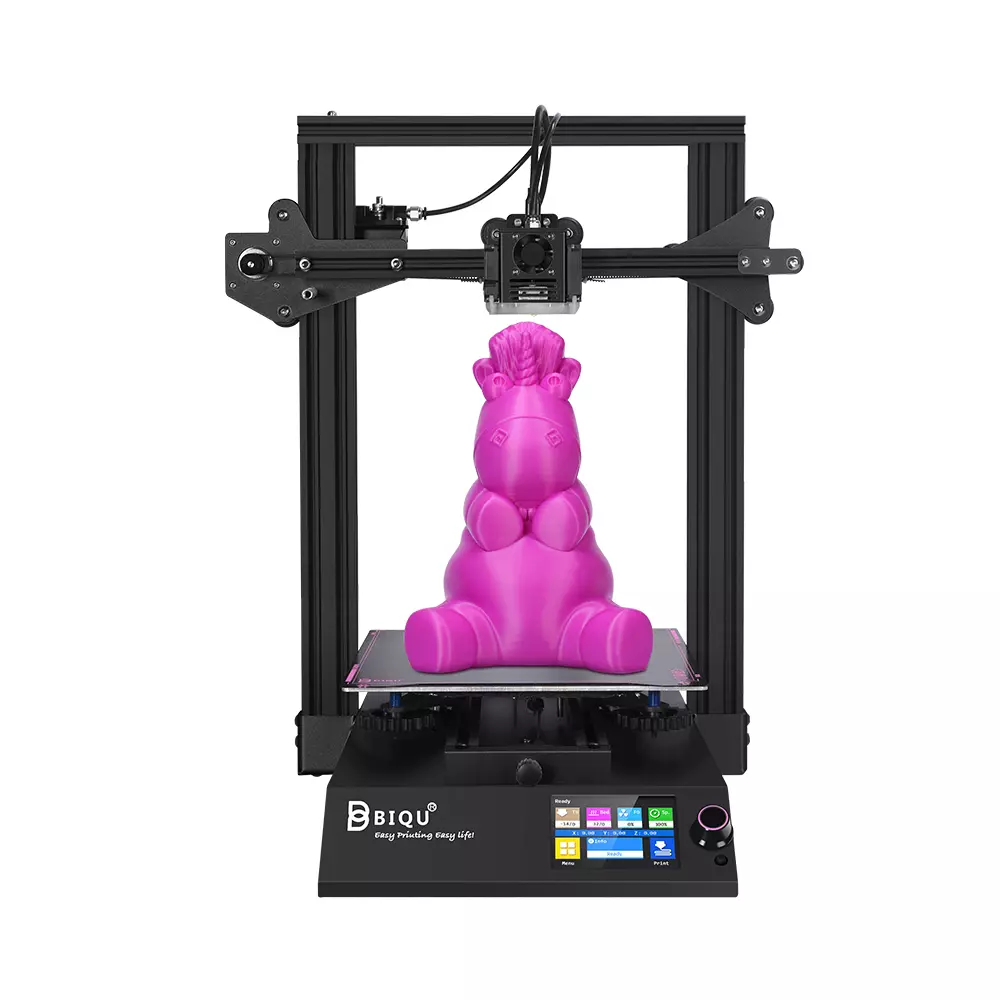Compare BIQU B1 vs CR 10 Smart Pro
Comparison between the best 3D printers
Choose the best 3D printer at the best price. The cheapest 3D printers are here.
Buy a 3D printer here with 3D Fila.
 |
 |
|
| Model | BIQU B1 |
CR 10 Smart Pro[BUY CR 10 Smart Pro] |
| Printing Material | Filament | Filament |
| Buy Filament for BigTreeTech BIQU B1 | Buy Filament forCreality 3D CR 10 Smart Pro | |
| Estimated price | $269,00 | $900,00 |
| Manufacturer | BigTreeTech | Creality 3D |
| Release Year | 2020 | 2020 |
| Print Volume [mm] | 235x235x270 | 300x300x400 |
| Printer Size [mm] | 412x402x492 | 578x522x648 |
| Weight [kg] | 8,00 | 13,6 |
| Power Loss Recovery | YES | YES |
| Enclosed printer | NO | NO |
| Bed Leveling | Manual | Manual |
| Filament End Sensor | YES | YES |
| Bed type | Heated | Heated |
| Power supply system | Bowden | Bowden |
| Standard nozzle | 0,4 | 0,4 |
| Maximum Nozzle Temperature [°C] | 250 | 300 |
| Maximum Bed Temperature [°C] | 100 | 100 |
| Maximum printing speed [mm/s] | 100 | 50 |
| Filament holder | YES | YES |
| Camera for supervision | NO | NO |
| Recommended filaments | PLA, TPU, ABS, PETG | PLA, PETG, Tritan, Flex, ABS |
| Recommended slicers | Cura, Simplify, Slic3r | Cura, Simplify, Slic3r, IdeaMaker |
| Maximum Resolution [mm] | 0,1 | 0,1 |
| Processor | 32 Bits BTT SKR V 1.4 | |
| Display | Touchscreen TFT 3,5'' | Display touchscreen 4,3'' |
| Power Supply | 24V / 360W | 110/220V / 350W |
| Connectivity | SD / USB | SD / USB / Wi-Fi / Ethernet |
| Operating systems | Windows, Mac, Linux | Windows, Mac, Linux |
| Date of registration in the system | 2021-04-14 | 2022-11-04 |
| Release date | 2020 | 2020 |
| Extra features | The BIQU B1 is an advanced 3D printer with a silent 32-bit BTT SKR V1.4 motherboard and ARM Cortex-M3 CPU, offering DIY interfaces (I2C, SPI, WiFi) and dual Z-axis. Its dual BTT B1 TFT35 V3.0 operating system allows real-time monitoring and multiple printing modes, including G-code visualization effects. It stands out for its BIQU SSS (Super Spring Steel), ensuring easy model adhesion and simplified removal, with the possibility of using it on both sides. It includes a filament sensor, automatically pausing printing in case of filament breakage. The multicolored RGB lights integrated into the hotend allow you to view the printing status even at night. Additional notes include the need for a BIQU-specific Type-C cable and extra interfaces for smart filament sensor and BL Touch. | Creality's CR-10 Smart Pro printer offers a large 300x300x400mm build volume, Sprite Pro direct extruder for multiple materials, CR Touch auto-leveling, PEI magnetic bed, 4.3" touchscreen, LED lighting, and Creality Cloud connectivity. Some areas of improvement include the use of brass spindle nuts and tinned wires. |
| Support for multiple colors and materials (AMS and CFS) | NO | NO |
Notes * |
||
| Cost-benefit | 7 / 10 | 6 / 10 |
| Hardware | 2 / 10 | 2.5 / 10 |
| Tela | . | . |
| Print volume | 3 / 10 | 4 / 10 |
| Performance | 1 / 10 | 1 / 10 |
| [BUY CR 10 Smart Pro] |
Conclusion |
| In comparing the BIQU B1 and the Creality CR-10 Smart Pro, several key factors stand out that can guide potential buyers in making the right choice based on their needs and budget constraints. Firstly, the BIQU B1 offers a significantly lower price, making it an appealing option for budget-conscious users. Despite its affordability, it provides impressive features such as a silent 32-bit motherboard, dual Z-axis, and effective filament sensor, which enhances its overall usability. The BIQU B1's print speed is superior at 100 mm/s, allowing for quicker job completion, and its smaller footprint makes it easier to accommodate in smaller spaces. On the other hand, the CR-10 Smart Pro, while more expensive, justifies its higher price with a larger print volume of 300x300x400 mm that caters to more ambitious projects. Its assistive bed leveling and direct extruder system enhance print reliability and support a wider range of filament materials. Moreover, the inclusion of features like auto-leveling, a larger touchscreen, and enhanced connectivity options, including Wi-Fi and Ethernet, elevate the user experience. Though the CR-10 Smart Pro shows slightly better hardware performance, the BIQU B1 holds its ground in cost-effectiveness. The former has been rated marginally higher in support for different materials and printing performance, but the BIQU B1 balances its features well with its value to the user. Ultimately, for users seeking affordability combined with essential 3D printing capabilities, the BIQU B1 presents itself as the better choice. Conversely, if one's requirements lean towards larger print volumes and advanced features, the CR-10 Smart Pro may be the preferable option, albeit at a higher cost. Assessing individual needs will be crucial in deciding between these two capable 3D printers. |

